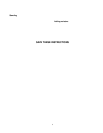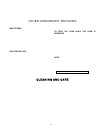
* Combination: applicable for both "microwave+grill", and "microwave+convection" cooking.
Cookware Microwave Grill Convection Combination*
Heat–Resistant Glass Yes Yes Yes Yes
Non Heat–Resistant Glass No No No No
Heat–Resistant Ceramics Yes Yes Yes Yes
Microwave–Safe Plastic Dish Yes No No No
Kitchen Paper Yes No No No
Metal Tray No Yes Yes No
Metal Rack No Yes Yes No
Aluminum Foil & Foil Container No Yes Yes No
Utensils Guide -
Recommended
·Microwave browning dish — Use to brown the exterior of small items such as steaks,
chops, or pancakes. Follow the directions provided with your browning dish.
·
Microwaveable plastic wrap — Use to retain steam. Leave a small opening for some
steam to escape and avoid placing it directly on the food
·Paper towels and napkins — Use for short-term heating and covering; these absorb
excess moisture and prevent spattering. Do not use recycled paper towels, which may
contain metal and could ignite.
·Glass and glass-ceramic bowls and dishes — Use for heating or cooking.
·Paper plates and cups — Use for short-term heating at low temperatures. Do not use
recycled paper, which may contain metal and could ignite.
·Wax paper — Use as a cover to prevent spattering.
·Thermometers — Use only those labeled “Microwave Safe” and follow all directions. Check the food in
several places. Conventional thermometers may be used on
microwave food once the food has been removed from the oven.
Limited Use
·
Aluminum foil — Use narrow strips of foil to prevent overcooking of exposed areas.
Using too much foil can damage your oven, so be careful. You should keep distance of 1 inch (2.54cm)
between aluminum foil and cavity.
·Ceramic, porcelain, and stoneware — Use these if they are labeled “Microwave Safe”.
If they are not labeled, test them to make sure they can be used safely.
6


















